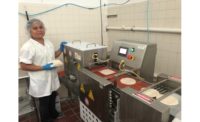
Lauren R. Hartman, Editor-in-Chief
Continuing the plan of expanding its presence in different product segments through developing new products and cultivating more customers, Grecian Delight Foods (GDF), Elk Grove Village, Ill., recently boosted its production capacity, product offerings and manufacturing footprint in a dramatic way with the addition of a newly renovated bakery production plant, a few miles away from its original site.
Opened in November 2010 to accommodate an aggressive growth strategy, the existing facility had at one time been a baking operation and went through at least a year’s worth of renovations and equipment installations, explains GDF president and chief executive officer Peter Parthenis, Jr. “We made an investment to purchase and remodel the second manufacturing facility into a first-class operation that occupies 130,000 sq. ft. This second facility predominately bakes and produces a variety of Mediterranean products. The addition of a new state-of-the-art bakery line for various flatbreads, buns and pizza crusts and more has enabled us to expand our product offering for our customers.”
Though the recent economic downturn has been difficult for most food manufacturers, GDF hasn’t skipped a beat in its efforts to fulfill its mission and goals. Since it first opened in 1974, it has produced enough gyro sandwiches to feed 18.5% of the world’s population. Demand for its large line of Mediterranean foods and traditional Greek-style dishes, flatbreads, pizza shells and pitas has kept the company on a brisk pace, says Parthenis, Jr. “We strive to produce quality according to customer’s specifications and our brand’s specifications first. I like to think this always trumps quantity,” he says. But quantity and high customer demand have been great enough for the company to open this second production plant with a high-speed bakery line.
Expanded capabilities
Also located in Elk Grove Village, the second plant and the new line include several new features that GDF is especially proud of, Parthenis, Jr. says. Equipped with a large ingredient storage corridor, in-line packaging and freezing, a large maintenance room, customer/quality assurance testing lab that can be used for auditing microbial content, shelf life and other customer-specific needs and, to the delight of the staff, a well-appointed employee workout room, the spacious facility was remodeled completely and is onstream to produce about 30 of the company’s stock-keeping units (SKUs). These include products in new categories, such as Indian flatbread, naan (available in classic and multigrain varieties), Middle Eastern flatbread, Lavash, traditional pitas and hand-stretched-style pizza crusts in a variety of flavors, shapes and sizes.
“[The new facility] allows us to increase our range of proofing time and has broadened our production capabilities to better meet our customers’ needs,” Parthenis, Jr. notes. “We are working diligently to fill production capacity for our new line. Our success will come to fruition by working closely with customers to meet their menu and consumer and operational needs and deliver effective solutions. We also expect to grow through acquisition.”
His father, company chairman and founder, Peter Parthenis, Sr., regularly walks around each department. “He is notorious for his saying, ‘the customer is No.1, so let’s make sure we satisfy and take care of their needs,’” says Parthenis, Jr.
GDF has been able to start tracking machine reliability and closely monitor downtime using lifecycle analysis studies, followed by equipment strategy sessions. These are carried out by production personnel to see if machinery should be repaired, rebuilt or replaced. That’s not a major issue with the new bakery line systems, which include automatic docking, metal detection, x-ray technology, automatic pallet wrapping and computer controls.
“We perform Hazard Analysis Critical Control Point (HACCP) checks all along the line,” says quality assurance director Mary Funteas.
Along with daily maintenance and sanitation functions, among its other features, the second production site has plenty of warehouse storage space for frozen and refrigerated products and raw ingredients. Food safety is very important at the facility, and Funteas ensures strict sanitation procedures. Various practices of environmental, food safety, quality control and other measures have also been put into place at the facility. Upon entering the mixing room, everyone is required to wash their hands. “The line at this plant usually runs a 10-hour shift, six days a week,” she observes.
Run time for buns
At the time ofSnack Food & Wholesale Bakery’s visit, the new flatbread line was running the 90-calorie, whole wheatSkinny Bunsthat are packed into eight-count clear film bags containing 11.2 oz. each.
Two large-capacity stainless-steel mixers at the head of the line mix up flour, oil, sugar and other ingredients as two operators look on before the mixers deposit the batch of dough into large bins. Flour, oil, sugar and other ingredients are pumped into the mixer hopper from large silos and tanks outside of the facility.
Various types of flour can be used, such as whole grain, whole wheat, white and more, depending on what’s being produced on the line at the time.
Next, the large bins of dough are brought to an extruder hopper and are dumped into the hopper to be extruded into a flat sheet below. As the dough conveys through a sheeter, which progressively flattens it via a series of reducing rollers, the thickness decreases to a specific standard before it proceeds into a cutting section.
The dough is then cut into rounds, and the line then progresses to a large-capacity spiral-conveyor proof box to relax and rise. Products can be proofed at various temperatures for anywhere from 0-45 min. and at various relative humidity (RH) percentages, depending on the quantity, customer requests, product type and other specifications, Funteas adds.
“We have the capability to adjust the proofer so that our line speeds stay the same, to keep up with the rest of the production,” says Funteas. For proprietary reasons, the company prefers not to discuss line speeds or proofing/baking temperatures.
Once proofed, the sandwich rounds enter the topping station before conveying toward a massive oven.
“We can apply all sorts of toppings, such as seeds, dried cheeses, herbs, oats and a number of other things,” she points out. The rounds are then automatically baked in a multi-zone straightline oven, says Funteas. Each zone also is set at a certain temperature (up to 1,000°F), depending on the product’s requirements.
After baking, random samples of the rounds are measured by line operators at a quality control point and the rest of the rounds convey through a vision-inspection station where several key parameters such as color, cell structure, size, thickness, weight and shape are checked both by operators and by the system, which automatically displays details on a large flat-screen monitor. The rounds then wind their way onto a spiral conveyor to cool at ambient temperatures.
Exiting the spiral conveyors, the cooled sandwich bun rounds then pass through a metal detection system and the conveyor splits into lanes on its way to the packaging department. An operator checks color and shape as the rounds head into a slicer and are stacked into groups of four. The stacks travel single-file into a film overwrapper and are grouped into rows prior to bagging as eight-packs in clear multicolor-printed film bags. The bags are immediately clipped closed with a bag clip imprinted with production information before the filled, closed bags are checkweighed and sent through another metal detector for an additional safety/quality check.
If the filled bags don’t measure up to GDF’s standards, the checkweigher will kick them offline into a tote. The finished bags then make a left turn on the conveyor for a final packoff into corrugated shipping cases, 12 bags per case. Other products that are supplied to local retailers can be tray-packed in open-topped plastic crates (some customers use returnable trays for environmental reasons). Operators then direct the cases into an automatic tape sealer. An open date coder applies an expiration date and a Julian date before the cases ofSkinny Bunsare palletized manually. Usually, the palletized loads are then automatically stretch-wrapped and transported by forklift to a spacious freezer (approximately 30,000 sq. ft.) that has four-high rack capacity.
The loads are then transported to a local distribution center for shipment nationwide by common carrier. The shelf life on the many different frozen bakery products varies, but is usually around six months, reports Amy Fattori, director of marketing.
Room to grow
The efficiencies built into the new plant offer room to add more production lines in the future,” Funteas says. “This is a deceptively large facility. We could actually be poised for two more lines. Depending on what product we need to run and what our customer requirements are, we change the equipment over to accommodate them. We can produce several flatbread sizes, shapes and flavors on this line.”
Says Parthenis, Jr., “There is so much potential here. The only downfalls in a family business and at least for me, are that you don’t ever turn the work switch off at 5 p.m. It’s on your mind 24/7, and it’s the topic of discussion at every dinner and family gathering. So it’s a challenge to manage the workload and balance family and personal time.”
But it’s worth it, he says. “Our ability to invest and expand with new products and value to customers in a difficult economic time is something I’m proud of as well as our long-term commitment to be a leader in specialty ethnic and Mediterranean foods.” It wouldn’t be surprising to see more expansions at GDF in the works.






